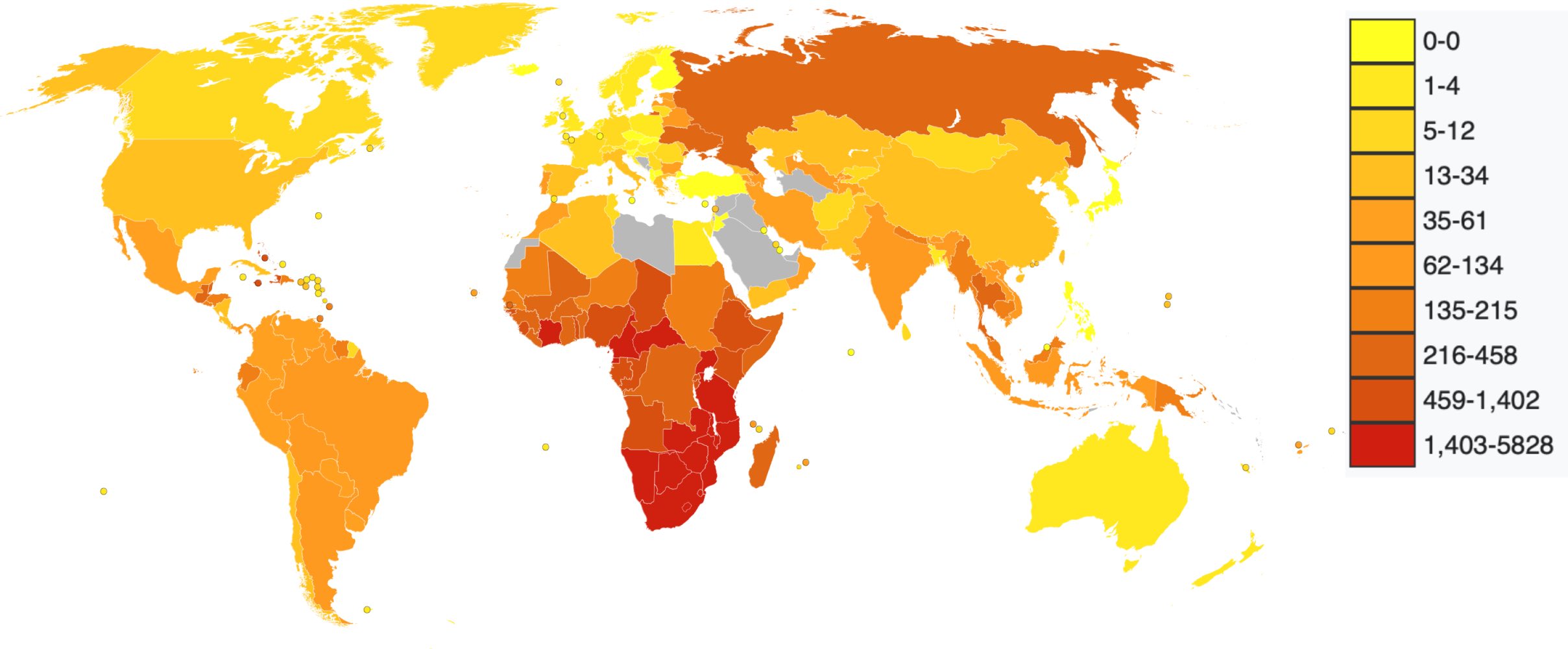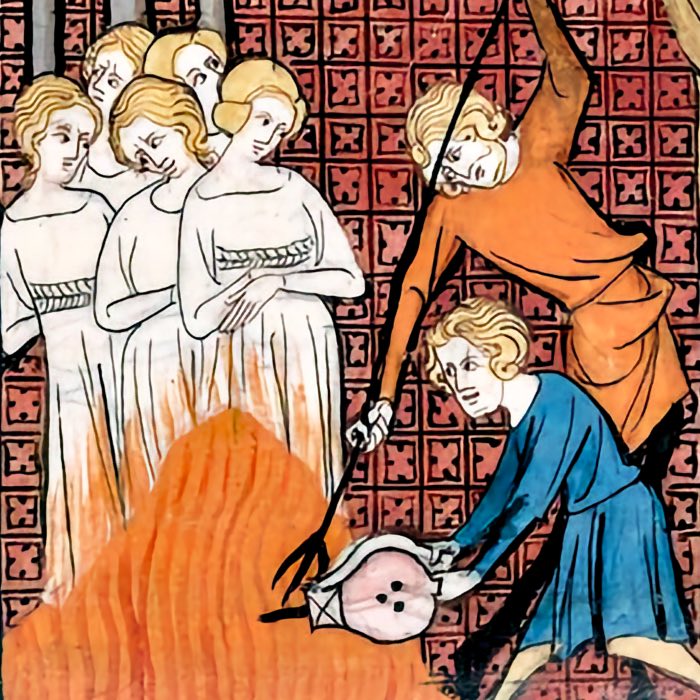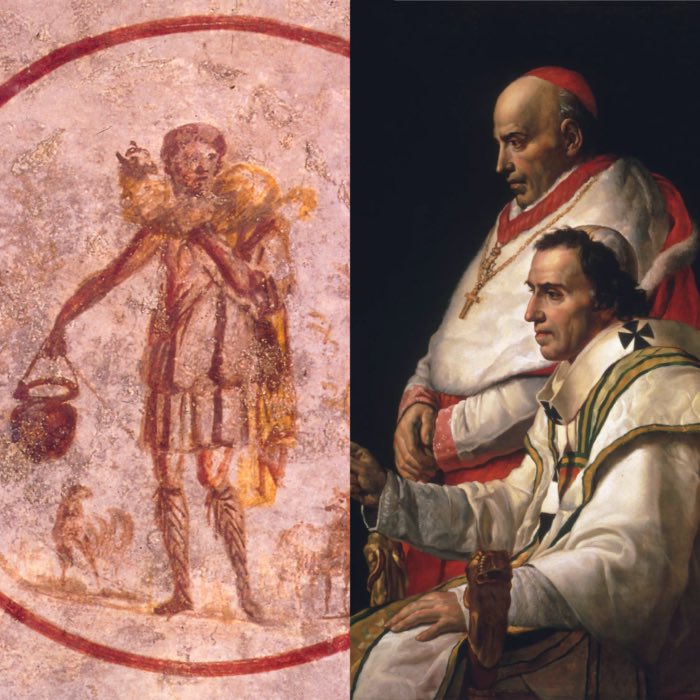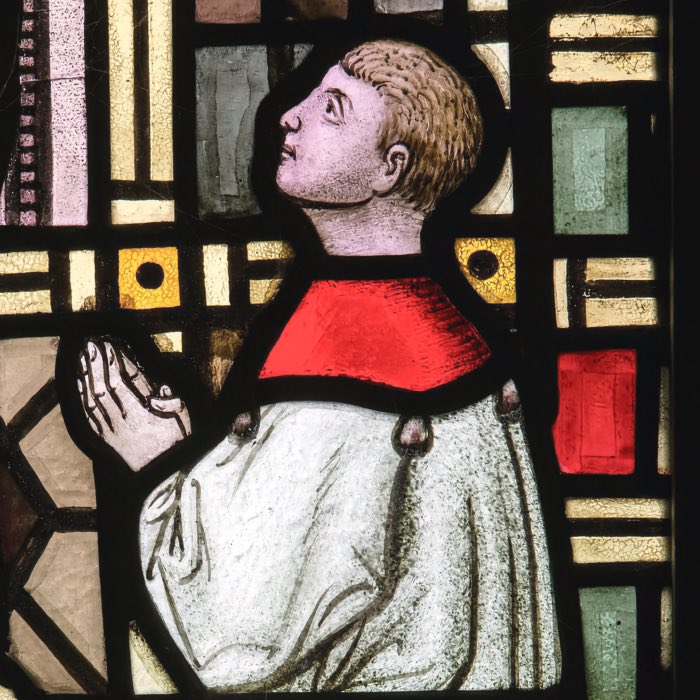HIV/AIDS in Africa: How the Catholic Church’s policies worsen the crisis
When I worked on the previous post on “Christianity’s death toll”, I was surprised to find out how many people are dying because of HIV/AIDS in Africa each year. The Catholic Church, which presents itself as a moral authority, has played a significant role in shaping public discourse on the epidemic. Its opposition to contraception, particularly condoms, has had dire consequences, especially in sub-Saharan Africa, where millions of lives have been devastated by HIV/AIDS. While the Church advocates for chastity and fidelity as means of prevention, its outright rejection of condoms has led to unnecessary suffering and loss of life. I thought this topic warranted a dedicated post to further examine the facts behind this deeply cynical and destructive stance.

Prevalence of HIV/AIDS in Africa over the years. Light orange: $\lt$1%; Orange: 1-5%; Dark orange: 5-10%; Red: 10-20%; Dark red: 20-38%, Grey: not data. Source: Wikimedia Commonsꜛ (license: CC BY-SA 3.0)
While this post focuses on the Catholic Church’s impact on the crisis in Africa, it is important to recognize that HIV/AIDS is a global pandemic affecting millions worldwide. The Church’s opposition to condoms and comprehensive sex education has had repercussions not only in Africa but also in regions such as Latin America and the Philippines, where Catholic influence remains strong.
Historical background
The AIDS epidemic emerged in the early 1980s, rapidly spreading across the globe and claiming millions of lives. Africa has been disproportionately affected, with over 25 million people living with HIV. Despite significant advances in treatment and prevention, the epidemic continues to pose a major public health challenge, particularly in countries with limited access to healthcare and education.
Early opposition and doctrinal stance
The Catholic Church’s opposition to artificial contraception dates back to Humanae Vitae, the 1968 encyclical by Pope Paul VI, which declared that all chemical and barrier methods of contraception were morally unacceptable. This position remained largely unchanged even as the HIV/AIDS epidemic emerged as a global crisis. The Church maintained that condoms, as a form of contraception, were not a permissible means of preventing disease transmission, reinforcing an abstinence-based approach instead.
1980s: The emergence of HIV/AIDS and Vatican intervention
As HIV/AIDS began spreading in the 1980s, a debate arose within the Church about whether condoms could be permitted as a means of disease prevention rather than contraception. In 1987, the U.S. Conference of Catholic Bishops proposed that educational programs could include condom use, but the Vatican, led by then-Cardinal Joseph Ratzinger, condemned this approach as facilitating sin rather than merely tolerating it. Catholic hospitals and institutions in New York sought and received exemptions from state requirements to provide condoms or AIDS-related education that contradicted Church teachings.
1990s: Pope John Paul II’s rigid stance
During the 1990s, Pope John Paul II reaffirmed the Church’s opposition to condoms, insisting that fidelity and abstinence were the only acceptable solutions to the AIDS crisis. His 1990 speech in Mwanza, Tanzania, explicitly condemned condom use, setting the tone for Catholic engagement with the epidemic in Africa. The Pontifical Council for the Family further declared in 1995 that parents must reject “so-called ‘safe sex’” education and condom promotion, branding them as dangerous and immoral.
2000s: Misinformation and scientific denial
In 2003, Cardinal Alfonso López Trujillo of the Pontifical Council for the Family falsely claimed that HIV could pass through latex condoms due to microscopic pores, a statement refuted by the World Health Organization as scientifically baseless. Despite mounting evidence that condoms significantly reduce HIV transmission, Pope Benedict XVI maintained the Church’s opposition, insisting in 2005 that combating AIDS required chastity and fidelity rather than contraceptive measures.
2010s: Pope Francis and the evasion of the issue
Unlike his predecessors, Pope Francis has largely sidestepped direct engagement with the condom debate. During his visit to Africa, he downplayed the Church’s role in AIDS prevention, instead focusing on issues like poverty and clean water access. While this shift in rhetoric appears to be an effort to avoid controversy, it ultimately allows the continued stigmatization of condom use in Catholic-majority regions.
The impact of the Catholic Church’s stance on HIV/AIDS prevention
HIV/AIDS is a global health crisis, with over 38 million people living with the virus worldwide. While sub-Saharan Africa is the hardest-hit region, the epidemic also significantly affects other parts of the world, including Asia, Latin America, and Eastern Europe. The Catholic Church’s restrictive stance on condoms has shaped public health responses in many of these regions, further complicating prevention efforts.

Deaths due to HIV/AIDS per million people in 2012. Statistics from WHOꜛ, grouped by deciles. In the year 2011, 1.7 million people died from AIDS-related illnesses (UNAIDS Report on the Global AIDS Epidemic 2012ꜛ). Source: Wikimedia Commonsꜛ (modified; license: CC BY-SA 4.0)
HIV/AIDS prevalence in Africa
Sub-Saharan Africa remains the region most affected by HIV/AIDS, with approximately 25 million people living with HIV. The epidemic is driven by a combination of factors, including limited access to healthcare, social stigma surrounding testing and treatment, and cultural norms discouraging open discussions about sexual health. Each year, over 1.2 million people die from AIDS-related illnesses, making the epidemic one of the deadliest public health crises in modern history. The impact is especially severe among young women, who account for a disproportionate number of new infections due to gender inequality, sexual violence, and lack of education.
Condom effectiveness in prevention
Scientific studies consistently demonstrate that consistent condom use reduces HIV transmission by 80–90% (Crosby & Bounse, 2012ꜛ, and other references listed below). Condoms act as a physical barrier that prevents the virus from spreading between partners. Their effectiveness has been confirmed through numerous epidemiological studies, which show that regions with widespread condom availability and education have significantly lower HIV transmission rates.
Despite this overwhelming scientific consensus, misinformation and religious opposition have hindered widespread adoption in some regions. Many Catholic-majority areas have lower rates of condom use due to religious teachings discouraging their promotion. In places where Church influence is strong, public health campaigns have struggled to reach populations with accurate information, leading to higher transmission rates. Furthermore, misconceptions — such as the false claim that condoms have microscopic holes through which HIV can pass — continue to circulate, reducing trust in this proven method of prevention.
The Catholic Church’s influence on HIV/AIDS policy
The Vatican’s stance has played a significant role in shaping HIV/AIDS prevention policies in many African nations. Countries like Uganda, Kenya, and Nigeria — where Catholic influence is strong — have witnessed public resistance to condom distribution and education programs. In Uganda, for example, early success in reducing HIV rates through a combination of abstinence, fidelity, and condom use was reversed when U.S. aid programs shifted towards promoting abstinence-only education, in alignment with Catholic teachings. The subsequent decline in condom distribution contributed to rising infection rates in some communities.
The Church’s moral authority has led to policies that prioritize abstinence-based approaches over scientifically proven prevention methods, hindering global health efforts. In some cases, Catholic hospitals — among the largest healthcare providers in Africa — have refused to distribute condoms even to married couples where one partner is HIV-positive, further exacerbating the crisis. The result is a public health paradox in which the institution that provides medical care for HIV/AIDS patients also upholds policies that contribute to the continued spread of the virus.
Conclusion
The Catholic Church’s opposition to condom use has had catastrophic consequences for millions of people, particularly in Africa. By promoting abstinence and marital fidelity as the sole means of preventing HIV transmission, the Church has actively undermined effective public health initiatives. While the Church claims to be a major provider of medical care for HIV/AIDS patients, its refusal to endorse condoms has directly contributed to the continued spread of the virus. The humanitarian efforts of Catholic institutions in treating AIDS patients cannot erase the moral culpability of an institution whose policies have exacerbated the crisis.
In this light, the Vatican’s approach to HIV/AIDS prevention appears not only misguided but deeply cynical. It simultaneously refuses to endorse proven preventive measures while positioning itself as a savior to those suffering from the very disease it has helped perpetuate. Until the Church acknowledges and reverses its stance, its role in the HIV/AIDS crisis will remain one of complicity rather than compassion.
References and further reading
- Karlheinz Deschner, Horst Herrmann, Der Anti-Katechismus - 200 Gründe gegen die Kirchen und für die Welt, 1993, Goldmann, ISBN: 9783442123438
- Karlheinz Deschner, Das Kreuz mit der Kirche. Eine Sexualgeschichte des Christentums, 1974, Econ, Düsseldorf 1974; überarbeitete Neuausgabe 1998, ISBN 978-3-9811483-9-8
- WHO data of deaths due to HIV/AIDS per million people in 2012ꜛ
- UNAIDS Report on the Global AIDS Epidemic 2012 (PDFꜛ)
- Crosby R., Bounse S., Condom effectiveness: where are we now?, 2012, Sexual Health. 9 (1): 10–17. doi: 10.1071/SH11036ꜛ, PMID 22348628ꜛ
- UNAIDS urges countries to invest in HIV prevention as key to ending AIDSꜛ
- Tao L., Liu M., Li S., Liu J., Wang N., Condom use in combination with ART can reduce HIV incidence and mortality of PLWHA among MSM: a study from Beijing, China. 2018, BMC Infect Dis., 18(1):124. doi: 10.1186/s12879-018-3026-8ꜛ, PMID: 29534685ꜛ
- Foss AM, Watts CH, Vickerman P, Heise L, Condoms and prevention of HIV, 2004, BMJ. 329(7459):185-6. doi: 10.1136/bmj.329.7459.185ꜛ, PMID: 15271806ꜛ
- Cates, Willard; Steiner, Markus J., Dual Protection Against Unintended Pregnancy and Sexually Transmitted Infections: What Is the Best Contraceptive Approach?, 2002, Sexually Transmitted Diseases. 29 (3): 168–174. doi: 10.1097/00007435-200203000-00007ꜛ, PMID 11875378ꜛ
- National Research Council; Division of Behavioral and Social Sciences and Education; Commission on Behavioral and Social Sciences and Education; Panel on Monitoring the Social Impact of the AIDS Epidemic, The Social Impact of AIDS in the United States, 1993, National Academies Press, ISBN: 978-0-309-04628-2
- Smith, Raymond A., Encyclopedia of AIDS: A Social, Political, Cultural, and Scientific Record of the HIV Epidemic, 1998, Routledge, ISBN: 978-1-135-45754-9
- Kalbian, Aline, Sex, Violence, and Justice: Contraception and the Catholic Church, 2014, Georgetown University Press, ISBN: 9781626160491
- Reference: Green, E. C., Rethinking AIDS prevention: Learning from successes in developing countries, 2003, Praeger Publishers, ISBN: 978-0865693166
- New York Times, Pope, in Africa, Says Condoms Aren’t the Way to Fight H.I.V., 2009, online: nytimes.comꜛ
- BBC, Pope condones condom use in exceptional cases, 2010, online: bbc.comꜛ
- BBC, Vatican plays down Pope’s remarks on condoms, 2010, online: bbc.comꜛ
- Wikipedia article on Catholic Church and HIV/AIDSꜛ
- Wikipedia article on HIV/AIDS in Africaꜛ












comments